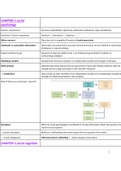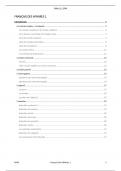CHAPTER 1 social
psychology
Science components Accuracy (replicability), objectivity, skepticism (replication), open-mindedness
Evolution’s 3 basic components Variation → Inheritance → Selection
Mirror neurons Play a key role in empathy & located in frontal operculum
Systematic vs naturalistic observation Observation accompanied by accurate measurement (e.g. survey method) vs observation
of behavior in natural settings
Experimentation issues Question of external validity arises ( can findings be generalized?), problem of
confounding varibábles
Mediating variable Variable that intervenes between an independent variable and changes in behavior
Meta-analysis Statistical technique that permits an assessment of how well findings replicate, effect &
strength points to gaps and biases in the scientific literature
→ moderators Factors that can alter the effect of an independent variable on the dependent variable &
strength of relationship between two variables
Role of theory in social psych. research
Deception Efforts by social psychologists to withhold or conceal information about the purpose of a
study from participants
→ passive deception Mild form: withholding information about the true purpose of the study
→ 2 basic safeguards Informed consent, debriefing → reduce dangers of deception
CHAPTER 2 social cognition
1
,Heuristics simple rules for making complex decisions or drawing inferences in a rapid manner and
seemingly effortless manner (mental shortcuts)
→ Representativeness = judgment judging by resemblance: a strategy for making judgments based on the extent to which
simplification strategy current stimuli or events resemble other stimuli or categories.
Ignore base rates = problem
→ Base rates The frequency with which given events or categories occur in total population
→ availability The easier it is to bring information to mind, the greater the impact on subsequent
judgements or decisions (especially dramatic events in the media): overestimation
→ Judgment involving emotions: rely on “ease” rule
→ Judgment involving facts: rely on “amount” rule
→ anchoring and adjustment A tendency to deal with uncertainty in many situations by using something we do know
as a starting point (anchor) and then making adjustments to it.
E.g. seller’s asking price provides a starting point, buyer tries to make adjustments to
lower price OR sale pricing/reductions
→ Portion size effect The tendency to eat more when a larger portion of food (high anchor) is received than a
smaller portion → anchoring and inadequate adjustment
→ Status quo heuristic: “what is good” options/ objects that are more easily retrieved from memory → judged in a heuristic
fashion as “good”, as better than objects/options that are new : old over new
Schemas Mental frameworks for organizing social information
→Impact on social cognition Attention, encoding, retrieval
→ attention cognitive load: schemas act as a filter
→ encoding information that becomes the focus of attention is more likely to be stored in long-term
memory
→ info consistent with our schemas is encoded
→ if inconsistent with our schemas: ‘flagged’, encoded into a different part of memory
and labelled with a unique ‘tag’
→ retrieval people report info consistent with schemas but info inconsistent with schemas may be
strongly present in memory too
→Priming Temporarily increases in the accessibility of specific schemas, implicit memory effect in
which exposure to a stimulus influences response to a later stimulus
→ Unpriming Effects of the schemas tend to persist until they are somehow expressed in thought or
behaviour and only then do their effects decrease/disappear
→ Schema persistence Schemas are often resistant to change
2
, → perseverance effect Scheme remain unchanged even in the face of contradictory information
→ self-fulfilling manner Make expectations come true
→ Metaphor A linguistic device that relates/compares abstract concept to another unrelated concept,
due to similarity,
When primed→ can influence behaviour
Automatic and controlled processing in
social thought
→ controlled processing Systematic, logical and highly effortful → prefrontal cortex (especially in the medial and
ventrolateral prefrontal cortex)
→ automatic processing Fast, relatively effortless, intuitive → amygdala, limbic system (emotions),
Make better decisions, in terms of satisfaction (compared to controlled)
Sources of error in social cognition
Optimistic bias predisposition to overlook risks and expect things to turn out well overall
Overconfidence bias The tendency to have more confidence in the accuracy of our own judgments than is
reasonable.
Planning fallacy The tendency to make optimistic predictions concerning how long a given task will take
for completion, people in powerful positions more likely (focused on goals and not on
steps to achieve the goal)
counterfactual thinking Situation specific sources of error: tendency to imagine other outcomes in a situation
than the ones that actually occurred (“What might have been”)
→ belief in free will encourages it
magical thinking Situation specific sources of error: assumptions that don’t hold up to rational scrutiny—
e.g. the belief that trying to avoid thinking about being called on in call will reduce the
chances of the professor calling on you
Terror management Our efforts to come to terms with certainty of our own death and its unsettling
implications (non rational thinking) belief in the supernatural
Affect and cognition
mood congruence effects : affect on We are more likely to store or remember positive information when in a positive mood
cognition and negative information when in a negative mood. Current mood = filter for memory
Mood dependent memory: affect on Current moods serve as retrieval cues. What we remember while in a given mood ,
cognition determined by what we learned when previously in that mood.
3
, Affective forecasts : cognition on affect Predictions about how we would feel about events we have not actually experienced
(often inaccurate)
2 systems : Reason vs affect Disrupted by cognitive load vs less sensitive to cognitive load
Processes through which we seek to understand other people
CHAPTER 3 social
perception
Nonverbal communication Facial expression, eye contact, body movement, posture, touching
→ 5 nonverbal basic channels
5 basic emotions Anger, fear, happiness, sadness, disgust
Gazing/eye contact vs staring High level of eye contact = liking or friendliness vs high level of staring = anger or hostility
Emblems (gestures) body movements that carry specific meanings in a given culture
Touch Can suggest friendliness, affection, sexual interest, dominance, caring, aggression
Paralanguage Type of nonvebral communication involving vocal effects other than speech e.g.tone,
pitch
Facial feedback hypothesis The view that facial expressions can actually trigger emotions
Deception Used almost 20% of people’s social interactions
→ microexpressions Cue of deception: Short lasting fleeting facial expressions
→ interchannel discrepancies Cue of deception: e.g. discrepancy between facial expressions and body language
→ exaggerated facial expressions Cue of deception: Smiling more frequently than usual or showing an exaggerated level of
interest on what we are saying
→ Other nonverbal cues of deception Higher pitch, slower response to questions, speed, pattern → linguistic style
Deception and mood Happy mood → increased attention to cue unrelated ro message content → reduced
ability to recognize deception OR
Sad mood → increased attention to message content → increased ability to recognize
deception
Attribution
Theory of correspondent inference (jones Other’s behaviors reflect their stable traits, when their behavior is freely chosen, yields
and Davis) distinctive, noncommon effects and is low in social desirability or otherwise violates
social norms
→ noncommon effects Conditions that can be caused by one specific factor, but not by others
Kelley’s covariation theory How we answer ‘why’ behavior occurs
4






